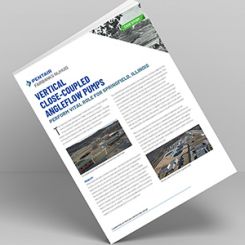Pumps & Systems, October 2008
Low efficiency, high radial loads, noise and vibration become a real problem when pumps operate to the left of the best efficiency point (BEP). Damage to the seal, shaft, couplings and poor reliability are direct results of such operation. This month, we will discuss a method to quantify inefficient operation of a pump. Position yourself in front of your computer to access a program written to quantify a pump's inefficient operation:
Step 1
Log onto https://www.pumpsandsystems.com/. Click on the Energy Estimator button under Resources on the left hand side.
Step 2
The following screen appears with a list of pumps:
 Click on a pump you want to evaluate (for example, 8x6-13). At this time, the program is based on actual catalogued data from a typical array of single-stage end-suction pumps, but can also be used, with reasonable accuracy, for an approximate evaluation of other types of single stage pumps as well.
Click on a pump you want to evaluate (for example, 8x6-13). At this time, the program is based on actual catalogued data from a typical array of single-stage end-suction pumps, but can also be used, with reasonable accuracy, for an approximate evaluation of other types of single stage pumps as well.
The objectives of the program are to provide the pump users with an approximate but simple method to evaluate:
- Average life cycle (20 years) cost of operating a pump across a random range of flows
- Energy used during the life cycle
- Typical cost of parts and energy used during the same life cycle
- Energy used by implementing an engineered hydraulic upgrade (such as, for example, shifting the BEP)
- Savings realized by the upgrade when a pump operates at the BEP, 75 percent of the BEP, 50 percent, 25 percent and an average random operation across the entire range of flows during the life cycle
- Life cycle cost savings via typical upgrade
Step 3
As an example, assume you selected 8x6-15 size, driven by a 150-hp motor (the program makes a simplified assumption that the motor is sized close to the power demanded by a pump at the BEP), with energy cost of $0.05 per kilowatt-hour. Let us also assume a proposed cost of the upgrade is $3200. The program responds by calculating seven months payback on the investment, and displays yearly and lifetime savings and energy as well as parts and labor due to improved reliability of the upgrade design:
Play with the numbers to get a feel for a magnitude of savings, based on the different input parameters. For example, if the energy cost doubles, the savings nearly double as well, and the payback period is reduced:
 Have fun playing with the numbers! While results are only approximate, you can nevertheless learn valuable estimates on the impact of the energy cost, pump size and its operating point in relation to the BEP with quantifiable answers. Enjoy!
Have fun playing with the numbers! While results are only approximate, you can nevertheless learn valuable estimates on the impact of the energy cost, pump size and its operating point in relation to the BEP with quantifiable answers. Enjoy!


